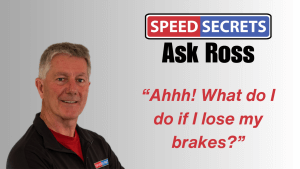Q: “One of the things that worries me the most when driving on track is losing my brakes, so I’d like to think ahead and be better prepared for that happening. What should I do if my car loses its brake completely? Should I try downshifting to slow my car? Should I aim at a tire wall? Should I try to spin my car?”
 A: Nine times out of ten (at least), I’d pump the brakes, no matter what kind of failure I was faced with. It might not work, but it will help more often than it won’t help. If it’s a blown brake line, it might pump up enough pressure in the other brakes to slow the car a bit.
A: Nine times out of ten (at least), I’d pump the brakes, no matter what kind of failure I was faced with. It might not work, but it will help more often than it won’t help. If it’s a blown brake line, it might pump up enough pressure in the other brakes to slow the car a bit.
I don’t think downshifting should be a priority. It’s rare that you’d have the time to actually do this beyond what you’re were already planning to do, so thinking about adding a downshift to everything else you’re doing in the panic is just going to make things worse. Okay, if you could do it without distracting yourself from other stuff, it could help. But I’d focus on what I suggest next….
Look where you want to go, no matter what. It’s human instinct to look at where you think you’re going to crash, but if you practice looking where you want to go all the time, you’re more likely to go in that direction in the fractions of a second before a crash. If you keep looking where you want to go – likely along the track, or at least away from any walls – you’re more likely to get there. If you look where you want to go, you’re going to minimize the negative effects of the loss of brakes. It is the number one thing to do.
Whether you try throwing the car sideways, hit another car, try to scrape it down a wall on the side, drive it straight off, or whatever… there is no way to recommend a one-size-fits-all option. I’m sorry to say this, but “it depends.” You might think that throwing the car sideways to scrub off speed might be a good solution, but it depends on what you’d be sliding on. If you watched what happened to Simon Pagenaud when he lost brakes at the end of the back straight in the Indy car weekend at Mid-Ohio in 2023, he went into the gravel sideways, and rolled so many times that he has a bad concussion. If there had been a large piece of paved area, that might have worked. Same for choosing to run into something (car, wall, etc.) – it depends. I believe that most drivers’ instincts are to not run into another car, and that’s probably a good thing because it’s probably not good to take someone else with you – someone who is just in the wrong place at the wrong time. I’d rather crash by myself than take someone with me.
If I had to give a driver a simple to remember “plan” that they could visualize to prepare, it would be “Look where you want to go, no matter what, and pump the brakes.” That’s not the right plan for every situation, but it will work more often than it doesn’t.
I touched on this topic in another Q&A here: https://speedsecrets.com/q-if-im-about-to-crash-into-a-wall-am-i-better-to-hit-it-head-on-or-sideways/
Also, I wrote a piece about brake fade on my Substack, and you can read it here: How to Manage Brake Fade. As I say in that article, rarely do brakes work perfectly at 100% and then suddenly go into catastrophic failure. A driver should be sensitive to what the brakes are feeling like, and read when they begin to fade.
